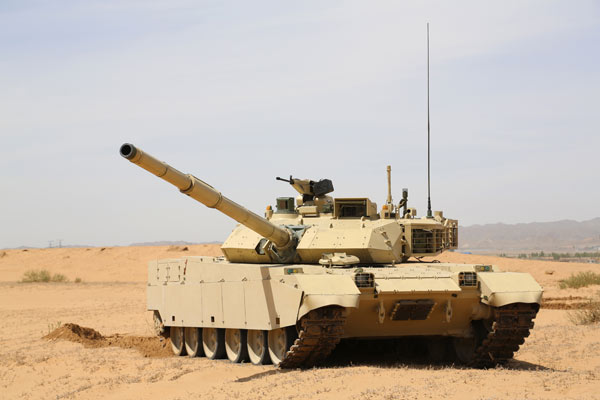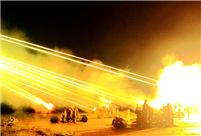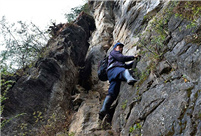

 |
| The high-end VT-4 tank is promoted by Norinco, its Chinese manufacturer, as an alternative to Russia's advanced T-14 Armata. Norinoco said its tank is better than the T-14 in terms of automation, mobility, fire-control systems and cost. Hu Yongye / for China Daily |
Norinco promotes weapon features on WeChat, a common messaging app
In an effort to increase sales of its tanks in the face of declining global demand, China North Industries Group Corp, the country's biggest developer and maker of land armaments, is turning to a popular smartphone social networking app.
WeChat is often used by Chinese arms producers to release comparisons between their weapons and other nations' products - contents that they would not put on their websites in consideration of diplomatic issues.
So, like many other State-owned defense technology enterprises, Norinco, as the tank maker is known, is promoting its brand and products to WeChat's more than 500 million users.
Most recently, it posted an article on its account that touts the ways its tanks are more usable than Russia's most-advanced T-14 Armata.
"Production lines of tanks have been closed in Western countries for a long time, so among large tank makers, only China and Russia have such facilities, which means if an international client wants to buy a new tank, it can only choose between China and Russia," said Norinco, the sole tank maker in China.
"Currently, Russia has only one new tank that is available for export - the T-90S. In contrast, we have the low-end VT-2, middle-end VT-1 as well as the high-end VT-4, covering the requirements of almost every client in the international market," the company said.
China is Russia's main competitor in developing countries seeking to buy tanks, and the tight market is becoming even more competitive for tank exporters. A report last year by the Center for Analysis of World Arms Trade in Moscow indicated that the global demand for new tanks will sharply decline from 2014 to 2017 compared with the previous four-year period, which is expected to further fuel the already fierce competition.
The T-90S, a third-generation Russian main battle tank, is just able to compete with the VT-1, while its upgraded version, the T-90AM, has no substantial improvements, according to Norinco. The VT-4's wide recognition on the international tank market is forcing Russia to put its cutting-edge T-14 on the market to change the situation, the company said.
Russia debuted the T-14 Armata on May 9 during a grand parade to celebrate the 70th anniversary of victory in World War II. Russian media noted that the weapon was the first fourth-generation tank to enter service globally, saying it would be one of the most powerful tanks in the future battlefield.
However, the assertion is being challenged by Norinco, which claims the Russian tank is weaker than the Chinese VT-4 in terms of automation, mobility, fire-control systems and cost competitiveness.
"The T-14's transmission is not well-developed, as we saw through a malfunction taking place during a rehearsal before the May 9 parade. By comparison, the VT-4 has never encountered such problems so far," Norinco said in the WeChat article. "Our tanks also have world-class fire-control systems, which the Russians are still trying to catch up with."
It continued: "Another important issue is the price - the T-14 is reported to have a price as high as that of the United States' M1A2 Abrams. ... Why don't buyers consider Chinese tanks that have well-developed technologies and equipment as well as much-lower prices?"
Features touted
To further influence potential buyers, Liu Song, a senior manager of research and development at Norinco, touted other VT-4 features: strong firepower as well as a cutting-edge data exchange network.
"It has an advanced fire-control instrument, a new-type active protection system and a state-of-the-art, fully automatic transmission device," he said. "In addition, the inter-unit network connects commanders of tanks and armored vehicles under a combat group, enabling them to share battlefield data in a real-time manner."
According to Feng Yibai, chief designer of the VT-4, the tank is equipped with an electronic-controlled diesel engine with 1,200 horsepower, giving the tank a cruise speed of 68 km per hour. Its main gun is a 125-mm smoothbore that can fire various shells, including kinetic energy penetrators and high-explosive anti-tank warheads. It can fire anti-tank missiles with a maximum range of 5,000 meters.
Even with heavy protective armor and strong firepower, the tank is much lighter in weight - 52 metric tons to 60 tons for its foreign rivals - making the VT-4 much faster, Feng said.
The VT-4 can compete with any first-class tank used by Western militaries, including the US M1A2 Abrams and Germany's Leopard 2A6, Liu said.
During a promotional event in August in the Inner Mongolia autonomous region, diplomats, military officials and defense contractors from 44 countries were shown a field performance by the VT-4 tanks and some other combat vehicles made by Norinco.
"Several countries have expressed interest in the VT-4 after their officials saw the tank's display, and we are negotiating with them on this matter," Liu said, without providing more details.
Feng said Pakistan's army will test the tank.
Rising competitor
Pakistan will not be alone in deploying the VT-4, as the tank will have strong appeal to Middle Eastern countries, according to Shi Yang, an independent military observer in Beijing.
One of VT-4's predecessors, the VT-1, has been in service in several nations, including Pakistan, Morocco, Bangladesh and Myanmar, and Norinco is sparing no effort to promote it to more buyers, especially developing countries, foreign media reported.
China also is developing a new-generation light tank specifically designed for operations in mountainous regions. The tank is equipped with a hydropneumatic suspension system that ensures better maneuverability and higher survivability, an earlier report said.
China exported a total of 461 tanks from 1992 to 2013, according to the United Nations' Register of Conventional Arms, which began to record conventional weapons transfers between UN member states in 1992. Pakistan bought 296 Chinese tanks during the two decades.
Russia sold 1,297 tanks during the same period, with Algeria being the largest buyer.
The biggest tank exporter during the period was the United States, which reported sales of 5,511 tanks. It was followed by Germany, which sold 2,680 tanks.
In 2013, the latest year for which data is available, China sold 98 tanks to foreign buyers. Bangladesh, with a 44-tank deal, was the largest customer through, the UN said.
 J-11 fighters in air exercise
J-11 fighters in air exercise Beauties dancing on the rings
Beauties dancing on the rings PLA soldiers operate antiaircraft guns in drill
PLA soldiers operate antiaircraft guns in drill Villagers pick cubiloses on cliff in Sichuan
Villagers pick cubiloses on cliff in Sichuan Blind carpenter in E China's Jiangxi
Blind carpenter in E China's Jiangxi Attendants-to-be join Mr. & Miss Campus Contest
Attendants-to-be join Mr. & Miss Campus Contest Beijing's toughest anti-smoking law takes effect
Beijing's toughest anti-smoking law takes effect China hosts overseas disaster relief exercise for the first time
China hosts overseas disaster relief exercise for the first time 20 pairs of twins who will become flight attendants in Sichuan
20 pairs of twins who will become flight attendants in Sichuan Defiance of Washington costs Blatter’s post
Defiance of Washington costs Blatter’s post Racing against the clock for ship survivors
Racing against the clock for ship survivors Escape room 2.0
Escape room 2.0 Tracking the MERS virus
Tracking the MERS virusDay|Week